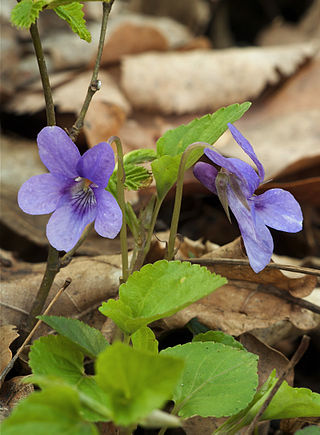
Viola is a genus of flowering plants in the violet family Violaceae. It is the largest genus in the family, containing over 680 species. Most species are found in the temperate Northern Hemisphere; however, some are also found in widely divergent areas such as Hawaii, Australasia, and the Andes.
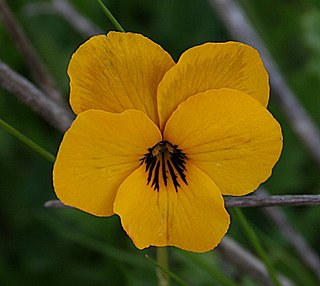
Viola pedunculata, the California golden violet, Johnny jump up, or yellow pansy, is a perennial yellow wildflower of the coast and coastal ranges in California and northwestern Baja California. The common name "Johnny jump up" is usually associated with Viola tricolor however, the introduced garden annual.

Viola riviniana, the common dog-violet, is a species of flowering plant in the family Violaceae, native to Eurasia and Africa. It is also called wood violet and dog violet. It inhabits woodland edges, grassland and shady hedge banks. It is found in all soils except those which are acid or very wet.
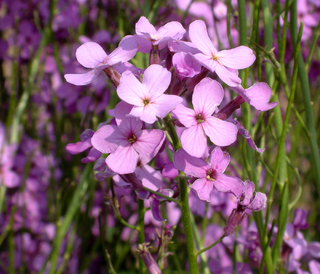
Hesperis matronalis is an herbaceous flowering plant species in the family Brassicaceae. It has numerous common names, including dame's rocket, damask-violet, dame's-violet, dames-wort, dame's gilliflower, night-scented gilliflower, queen's gilliflower, rogue's gilliflower, sweet rocket, and mother-of-the-evening.

Caltha leptosepala, the white marsh marigold, twinflowered marsh marigold, or broadleaved marsh marigold, is a North American species of flowering plant in the buttercup family. The species has regionally distinct variations.

Viola reichenbachiana, also known as the early dog-violet, pale wood violet, slender wood violet, hedge violet, or wood dog violet, is a species of flowering plant in the Viola genus. This species hybridises with Viola riviniana, the common dog-violet, to produce Viola × bavarica. The plant is named after the 19th century botanist Ludwig Reichenbach. It is a rhizomatous herbaceous perennial that is widely known for its purple petals, and it typically resides along road banks or among other rich vegetation, as other wild pansies do. The name dog violet refers to its lack of scent, making it supposedly only fit for dogs.
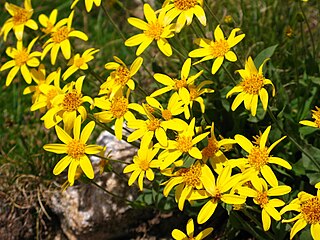
Packera werneriifolia, known by the common names alpine rock butterweed and hoary groundsel, is a species of flowering plant in the aster family. It is native to the western United States in the Sierra Nevada mountain habitat in subalpine and alpine climates, including forests and barren talus.

Viola langsdorffii is a species of Viola. Commonly known as Alaskan violet and Aleutian violet, it is a plant from rather stout creeping rootstocks, glabrous, the stems ascending 5–30 cm long. V. langsdorffii has leaves that are long-petioled, round-cordate, and anywhere from 2.5 to 4 cm broad, crenate; stipules foliaceous, lanceolate, the lower usually incised. The flowers are pale violet, with petals 12–16 mm long, the three lower white at base, the lateral pair bearded; spur very short and stout, as broad as long; the head of styles not bearded. Alaskan and Aleutian specimens, with petals 20 mm long, are more robust than specimens from further south in it range.

Viola bertolonii is a species of violet known by the common name Bertoloni's pansy, belonging to the Violaceae family.

Roscoea cautleyoides is a perennial herbaceous plant occurring in the Sichuan and Yunnan provinces of China. The scientific name is also spelt Roscoea cautleoides. Most members of the ginger family (Zingiberaceae), to which it belongs, are tropical, but R. cautleyoides, like other species of Roscoea, grows in much colder mountainous regions. It is sometimes grown as an ornamental plant in gardens.

Saxifraga bryoides is a species of saxifrage known by the common name of mossy saxifrage. In German it is known as Moosartiger Steinbrech. It is an inhabitant of the Alps and other mountain ranges at high altitudes in continental Europe.

Aciphylla aurea, known as taramea in Māori and golden speargrass or golden Spaniard in New Zealand English, is a large, spiky, tufted plant with sharp yellowish-green leaves in the speargrass genus Aciphylla. A. aurea is found throughout the South Island of New Zealand in montane to low alpine habitats.
Caltha scaposa is a low, perennial herb with one or two yellow hermaphrodite saucer-shaped flowers. This marsh-marigold species belongs to the buttercup family, grows in moist alpine fields and is native to the eastern Himalayas and the mountains on the eastern margin of the Tibetan highland.
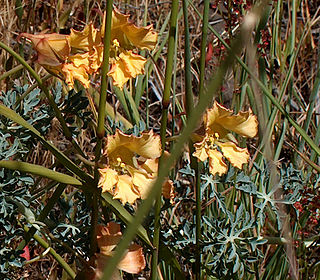
Tropaeolum incisum is a species of nasturtium, with flaring petals in shades of yellow and peach, when still in bud and on the outside darker, more orange-brown and sometimes stained purple, with creeping or climbing stems, in the wild up to about 60 cm long with deeply divided, blue-grey leaves, with undulating lobes, that grows on the dry eastern side of the southern Andes mountains.

Pelargonium luridum, locally called variable stork's bill, is a medium high, tuberous herbaceous perennial geophyte, belonging to the Stork's bill family, with white to pink, slightly mirror symmetrical flowers in umbels on long unbranched stalks directly from the ground rosette that consists of few initially ovate, later pinnately incised or linear leaves, with blunt teeth around the margin. The variable stork's bill naturally occurs from South Africa to Angola, southern Congo and Tanzania.
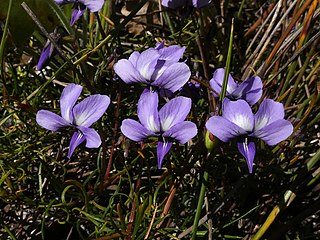
Viola decumbens is a perennial plant with a woody base that is assigned to the violet family. It has linear leaves and stipules. The bilaterally symmetrical purple flowers have five petals and a spur. It grows in fynbos and is an endemic species of the southern Western Cape province of South Africa, where it is called wild violet, a name used for other species elsewhere in the world.
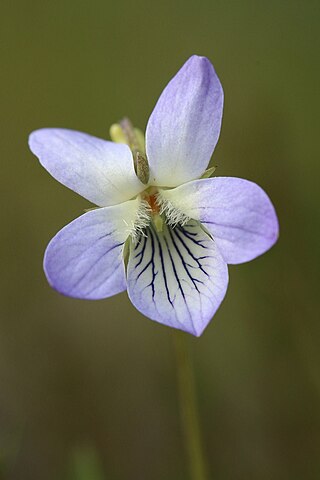
Viola lactea, also known by its common name pale dog violet, is a species of flowering planet of the family Violaceae.
Pultenaea villifera is a species of flowering plant in the family Fabaceae and is endemic to two disjunct areas of Australia. It is an erect to prostrate shrub with triangular to linear, egg-shaped to elliptic leaves and yellow and red, pea-like flowers.
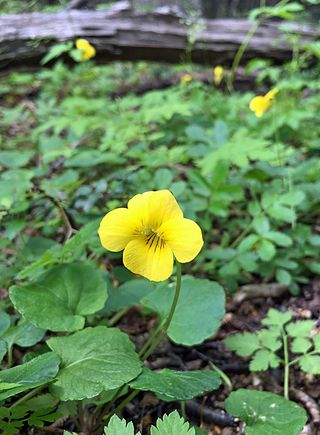
Viola reichei, also known as the Patagonian yellow violet, is a flowering plant species of the genus Viola.

Viola gracilis, also known as the Olympian violet, is a species of flowering plant within the family Violaceae.

















